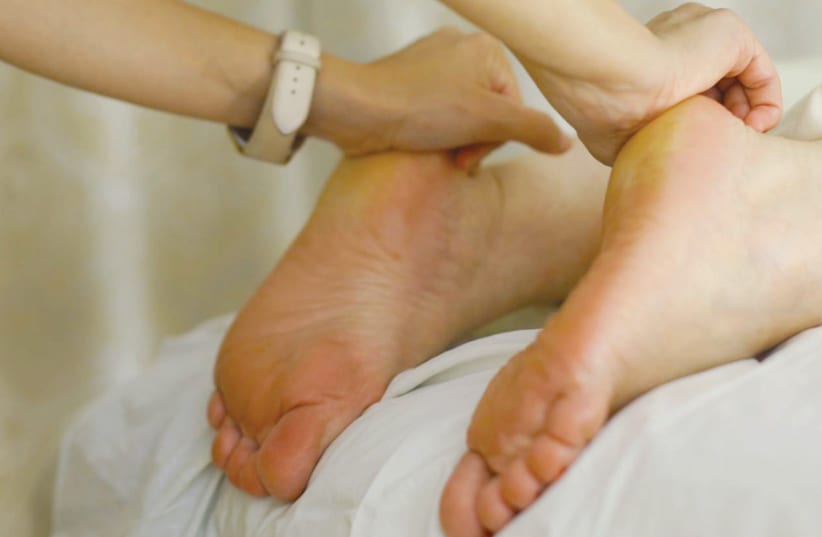While no one ever wants to get cancer, there are a few “benefits” to having the disease.
In Israel, they fall into several buckets: financial (discounts on taxes), bureaucratic (my health fund assigned me a medical representative to help expedite drug approvals and shepherd paperwork), pharmaceutical (it was easy-peasy to get a medical cannabis license), spiritual (our “healing holiday” at the Ritz Carlton through the Refanah organization) and physical. The latter is perhaps best exemplified by the Yuri Shtern Holistic Center, which provides inexpensive touch and alternative therapies for both cancer patients and their caregivers.
Yuri Shtern was a member of Knesset who made aliyah in 1981 from Moscow. He initially joined Natan Sharansky’s Yisrael B’Aliya Party and later moved to Yisrael Beytenu. Shtern was actively involved in bringing thousands of refuseniks to the Jewish state and founded the Knesset Christian Allies Caucus in 2004.
Shtern died of cancer in 2007. During the last year of his life, Shtern’s wife, Lena, organized a variety of holistic treatments, which she says significantly helped improve the quality of her husband’s life.
Lena wanted to bring the same benefits to others suffering from cancer. She established the center in her husband’s name later that year, first at Shaare Zedek Medical Center and later adding a clinic in Jerusalem’s German Colony.
More than a decade later, the Yuri Shtern Holistic Center now draws on the experience of 142 therapists, all of whom are volunteers (they give three hours a week of their time). That adds up to about 900 treatments a month – or nearly 11,000 treatments a year in total.
There’s also a 40-hour training program so the therapists can understand the unique needs of cancer patients.
Treatment at Shaare Zedek is free. At the clinic, there’s a nominal fee of NIS 65 per treatment. At 40 minutes each, sessions are relatively short, but that’s still a fraction of the going price in Israel for such therapy of NIS 250 and up.
Those suffering from cancer get up to two treatments a week for five years. Lena Shtern understood that caregivers need care, too; they can receive two treatments a month.
I started going to the German Colony clinic about two weeks after my chemotherapy started and took a smorgasbord approach to what’s on tap, trying out a different therapist each time. I’ve done all manner of massage (shiatsu, Swedish and Thai), reflexology (a focused foot massage with medical intent), and a kind of energy healing called craniosacral therapy.
Also available: yoga, chi gung, focusing, Breema, reiki, Feldenkrais Method, acupuncture and traditional talk therapy.
WHILE I’M not a professional massage connoisseur, I have had bodywork all over the world. On a trip to Bali a few years ago, my wife, Jody, and I had a massage a day – at $7 for an hour treatment, how could we not? We even had a full day at a spa for under $50 – including lunch.
In Bangkok, we sought out the famous massage school on the grounds of the Wat Pho temple. My masseur was excellent but a bit too chatty. I think he was trying to improve his English.
In Nepal, after hiking 11 days in the Himalayas, we treated ourselves to a massage in Kathmandu. The idea was sound, but the masseuse went to town on my back, and I left there achier than when I arrived.
A massage at a five-star hotel in India found me completely naked on a hard wooden table. No soft mattress, no pillow for my head, no towel (and no relief from pain when he dug into my shoulders).
So how do the treatments at Yuri Shtern compare? It, of course, depends on the therapist, but I’ve been very pleased. When you’re feeling as rotten as I sometimes did after chemo, any touch is welcome.
As has been getting to know the therapists.
Some are professionals who work in the field when they’re not volunteering. Others are on second careers. For example, Ruth was a speech therapist who now does medical and Thai massage.
“No one ever said to me, ‘Wow, that was amazing, I loved it,’ after a speech therapy session,” Ruth told me. But that’s exactly how I reacted after her massage.
For the past few months, I’ve been returning to my favorite masseuse, who specializes in deep-tissue massage. One day, the appointment after me canceled at the last minute, and I was offered a double session. It was hands down the best massage I’ve ever received.
THE YURI SHTERN clinic is the only one of its kind in Israel. There are other organizations offering medical massage, but not with volunteers and not at such discounted prices.
There’s certainly the need. According to the Israel Cancer Association, there are 250,000 cancer patients in the country, with more than 30,000 new cases of cancer being diagnosed every year.
Shaare Zedek oncologist Dr. Nathan Cherny summed up the benefit Lena Shtern has brought to the cancer world in Israel. In a video made when the clinic was getting started, he pointed out: “Quite often, patients tell us ‘We thought we were coming to the oncology department, but we feel as if we came to a spa.’”
While the price to gain access to this wonderful world is steeper than anyone ought to pay, it’s been a relief to know that a break from my day-to-day cancer experience is just down the street.
The writer’s book, Totaled: The Billion-Dollar Crash of the Startup that Took on Big Auto, Big Oil and the World, is available on Amazon and other online booksellers.
